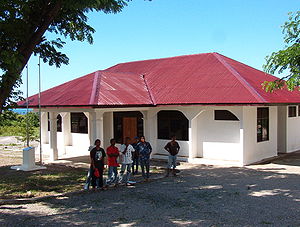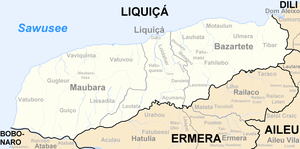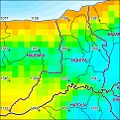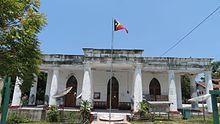Liquiçá
| Liquiçá administrative office | ||
|
|
||

|
||
| Administrative headquarters | Date | |
| surface | 93.91 km² | |
| population | 22,128 (2015) | |
| Sucos | Population (2015) | |
| Açumanu | 1.911 | |
| Darulete | 1,872 | |
| Date | 9.314 | |
| Hatuquessi | 2,899 | |
| Leotala | 2,543 | |
| Loidahar | 2,796 | |
| Luculai | 793 | |
| Overview map | ||

|
||

|
||
Liquiçá ( tetum Likisá , other spellings: Liquica, Likisia, Liquissa, Likisa, Liquisa) is an East Timorese administrative office ( Portuguese Posto Administrativo ) in the municipality of Liquiçá . The seat of the administration is in the western part of Vila de Liquiçá , in Suco Dato . The name "Liquiçá" is derived from the old name "Liku Saen" , which means " Python ".
Geography and inhabitants
Until 2014, the administrative offices were still referred to as sub-districts . Before the 2015 regional reform, Liquiçá had an area of 98.58 km². Now there are 93.91 km².
The Liquiçá administrative office forms the central part of the municipality. To the west lies the Maubara administrative office , to the east the Bazartete administrative office . In the south lies the municipality of Ermera with its administrative offices Hatulia and Ermera and in the north the Strait of Ombai , an extension of the Sawu Sea . Liquiçá is divided into seven sucos : Açumanu ( Acumano , Asumano , Assumano ), Darulete ( Durulete ), Dato with the place Liquiçá, Hatuquessi ( Hatukesi ), Leotala ( Leoteala , Leotela ), Loidahar and Luculai ( Lukulai ). The Sucos Dato and Loidahar are classified as " urban ". They form the west and the center of the municipality capital Vila de Liquiçá . The eastern part of the city lies in the neighboring administrative office of Bazartete.
Liquiçá has 22,128 inhabitants (2015), of which 11,080 are men and 11,048 women. The population density is 235.6 inhabitants / km². The largest language group are the speakers of the national language Tokodede . The average age is 18.5 years (2010, 2004: 17.1 years).
Near Vila de Liquiçá is the Fazenda Algarve of the Carrascalão family , from which several important East Timorese politicians come. It is the last plantation still owned by the same family as it was in colonial times.
- Climate data
history
Liquiçá was one of the traditional empires of Timor, ruled by a liurai . It appears on a list by Afonso de Castro , a former governor of Portuguese Timor who listed 47 empires in 1868. According to European sources, it ruled east Timor together with Luca in the 16th century . Here Liquiçá is referred to as Likusaen . In 1886, the island of Alor , which belongs to the Netherlands, paid tribute in the form of rice, corn, cotton and other things.
Under Governor Vitorino Freire da Cunha Gusmão , coffee was first planted in Portuguese Timor in 1815 in the coastal regions west of Dili and in Liquiçá. It had previously been introduced in Maubara, which was then still in the Netherlands. During the rebellions in Portuguese Timor between 1860 and 1912 , the Liurai of Liquiçá was a loyal ally of the Portuguese colonial rulers , who several times provided troops to suppress the rebellions. In 1889 the Portuguese post in Liquiçá was renewed.
During the Second World War , Portuguese Timor was occupied by the Japanese. In Liquiçá and Maubara , the entire remaining Portuguese population was interned in camps from the end of October 1942. The conditions in the camp were poor, food was scarce and the hygienic conditions inadequate due to a lack of water. Many Portuguese died because of it. Although there was a Portuguese doctor who was later assigned two Japanese doctors, there was a lack of medicine. During the first year Japanese soldiers guarded the camp, later Japanese Kempeitai , along with Timorese guards and spies.
In Suco Açumanu, during the civil war against FRETILIN on August 13, 1975 , the UDT raised its flag in the Aldeia Caicasaico , burned houses and murdered six people in the Aldeia Siscoelema and Hatumatilu . Parts of the population fled to Leorema , Maubara or the nearby forest.
During the Indonesian invasion , Indonesian troops attacked Liquiça in June 1976 . Here, too, there were massacres of the civilian population. The last parts of Liquiça, like Leotala, were conquered in early 1978. At the end of 1979 there were so-called transit camps in which the occupiers interned East Timorese civilians in Liquiçá, Caicasaico, Dato and Hatarlema (Suco Hatuquessi). Between 1970 and 1980, the population in the Liquiçá administrative office fell by 45.8% from 16,416 to 8,895. On May 29, 1997, elections were held in which representatives of East Timor should be elected to the Indonesian parliament. Several attacks on the Indonesian occupying power and its supporters took place in the surrounding area. A hand grenade was thrown into the polling station in Açumanu. One soldier was wounded.
The then Liquiçá district was a center of the wave of violence before and after the independence referendum and the scene of intimidation, rape and murder by pro-Indonesian militias . From January 1999 up to 5,100 refugees gathered in Faulara (Suco Leotala), a resettlement camp that had existed since 1996 and originally had 1,600 residents. Some of the refugees were also housed in branch offices, such as Banitur ( Bantur ), eight kilometers away . On April 5, the Vila de Liquiçá was attacked by the Besi Merah Putih (BMP) militia . At least seven people died, 150 houses were burned down, and more than a thousand people sought protection in the main church and the adjoining parish hall, where they were surrounded the next day by the militias Besi Merah Putih and Aitarak , with the participation of Indonesian police and soldiers. In the following church massacre in Liquiçá , between 61 and 200 people died, depending on the source. Later the inhabitants of Luculai, Loidahar and Darulete were forcibly deported to Vila de Liquiçá. Here they were forced to use intimidation and abuse to support the autonomy solution in the referendum, which provided for East Timor to remain with Indonesia. If they did not flee, men were forcibly recruited into the militia. In addition, people had to raise the flag of Indonesia and set up guard posts. Girls and young women had to dance at militia celebrations. About 150 people fled to Dili, where they sought refuge in the house of the politician Manuel Carrascalão , who was attacked by the militia itself on April 17th (see the massacre in the house of Manuel Carrascalão ). On July 4, 1999, the pro-Indonesian militia Besi Merah Putih (BMP) attacked an aid convoy in Liquiçá, which was accompanied by UNAMET and UNHCR employees . Of the 77 people in the convoy, several local employees were seriously injured and the vehicles were destroyed with bars and stones. 62 members of the convoy escaped to the police station. Later they could return to Dili. Indonesian police officers and members of the secret service who were present did not intervene. On the contrary. One week after the incident, the Indonesian police began an investigation into a UN worker for alleged possession of weapons. On July 16, the BMP attacked the camp in Faulara and on July 18 on Vila de Liquiçá, whereupon people again fled into the mountains. During the riots by the militias, most of the buildings in Vila de Liquiçá were destroyed, only a few buildings from Portuguese and Indonesian times remain.
300 families were left homeless when floods devastated the Sucos Dato and Luculai in Liquiçá and the Suco Maumeta in neighboring Bazartete on January 1 and 2, 2008 . 100 houses were completely destroyed, 90 more damaged. The population was able to be evacuated by the national police in time, so that no people were harmed.
On July 9, 2009, the Aldeias Caileli , Lebu-Ae , Manupatia and Carulema ended an enmity that had existed since the 2006 riots in Suco Darulete with an official peace ceremony.
A forest fire on October 2 and 3, 2019 caused major damage to the administrative office.
politics
The administrator of the administrative office is appointed by the central government in Dili. In 2015 it was Renato Nunes Serão .
economy
73% of the households in the administrative office grow corn, the same amount of cassava, 71% vegetables, 67% coconuts, 55% coffee and 6% rice. The latter is mainly grown on the Lauveli River .
Personalities
- João Viegas Carrascalão (* 1945), East Timorese politician
- Natália Carrascalão Antunes (* 1952), Portuguese politician and East Timorese diplomat
- Maria de Lourdes Martins Cruz (* 1962), nun and recipient of the Ramon Magsaysay Prize
- Calisto dos Santos (* 1959), officer
- Lídia Norberta dos Santos Martins (* 1980), politician
Town twinning
Web links
- City of Moonee Valley: Liquiçá, East Timor Friendship City relationship
Individual evidence
- ↑ a b c d e Direcção-Geral de Estatística : Results of the 2015 census , accessed on November 23, 2016.
- ↑ Jornal da República : Diploma Ministerial no 24/2014 de 24 de Julho - Orgânica dos Postos Administrativos ( Memento of March 4, 2016 in the Internet Archive )
- ↑ Suai Media Space: Koba Lima - Suai
- ↑ a b Direcção Nacional de Estatística: 2010 Census Wall Chart (English) ( Memento of the original from August 12, 2011 in the Internet Archive ) Info: The archive link was automatically inserted and not yet checked. Please check the original and archive link according to the instructions and then remove this notice. (PDF; 2.5 MB)
- ^ Ministry of Finance of East Timor: Liquiça Suco Reports
- ↑ Direcção Nacional de Estatística: Census of Population and Housing Atlas 2004 ( Memento of November 13, 2012 in the Internet Archive ) (PDF; 14.0 MB)
- ↑ a b c Seeds of Life
- ↑ TIMOR LORO SAE, Um pouco de história ( Memento of the original dated November 13, 2001 in the Internet Archive ) Info: The archive link was inserted automatically and has not yet been checked. Please check the original and archive link according to the instructions and then remove this notice.
- ↑ East Timor - PORTUGUESE DEPENDENCY OF EAST TIMOR ( Memento of February 21, 2004 in the Internet Archive )
- ↑ a b History of Timor - Technical University of Lisbon ( Memento of the original from March 24, 2009 in the Internet Archive ) Info: The archive link has been inserted automatically and has not yet been checked. Please check the original and archive link according to the instructions and then remove this notice. (PDF; 824 kB)
- ↑ a b c d e "Chapter 7.3 Forced Displacement and Famine" ( Memento of the original from November 28, 2015 in the Internet Archive ) Info: The archive link was inserted automatically and has not yet been checked. Please check the original and archive link according to the instructions and then remove this notice. (PDF; 1.3 MB) from the "Chega!" Report by CAVR (English)
- ↑ "Part 3: The History of the Conflict" (PDF; 1.4 MB) from the "Chega!" Report of the CAVR (English)
- ↑ (INDONESIA-L) HRW / ASIA - East Timor Guerrilla Attacks: East Timor Guerrilla Attacks of June 4, 1997 ( Memento of September 19, 2006 in the Internet Archive )
- ↑ ETAN : July 4 Militia Attack on the Humanitarian Team in Liquiça: Another Slap in the Face to the UN (Summer 1999) ISSN 1088-8136
- ↑ Relief Web, January 7, 2008, Timor-Leste: Humanitarian update, Dec 21 - Jan 7, 2008
- ↑ United Nations Development Program, July 16, 2009, Embracing Dialogue in Timor-Leste ( Memento from February 9, 2011 in the Internet Archive )
- ↑ Ministério da Administração Estatal: Administração Municipal ( Memento of the original from June 1, 2016 in the Internet Archive ) Info: The archive link has been inserted automatically and has not yet been checked. Please check the original and archive link according to the instructions and then remove this notice.
- ↑ Direcção Nacional de Estatística: Suco Report Volume 4 (English) ( Memento of the original from April 9, 2015 in the Internet Archive ) Info: The archive link was inserted automatically and has not yet been checked. Please check the original and archive link according to the instructions and then remove this notice. (PDF; 9.8 MB)
- ^ Website of the Ministry of Foreign Affairs of East Timor ( Memento from May 15, 2013 in the Internet Archive )
Coordinates: 8 ° 36 ′ S , 125 ° 20 ′ E










